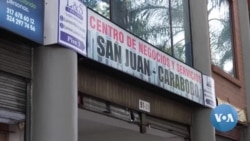New U.S. processing centers set up for migrants in Latin America were marketed as a way to make it easier to access legal pathways to the United States and avoid making the dangerous trek to the U.S.-Mexico border. But would-be migrants are finding that the centers do not yet offer faster options for people who wish to flee urgently.
The majority of people determined eligible by the centers so far have been referred to the U.S. refugee program, according to a State Department official – a process that has historically taken years to complete. Others may get information from the centers about alternative visa options. Even if eligible, people who may have hoped for rapid access to the U.S. still must take existing, often backlogged pathways.
Voice of America visited the first Movilidad Segura office – or "Safe Mobility" in English — to open in downtown Medellin, Colombia, a satellite location of the United Nations Refugee Agency (UNHCR). Migrants who apply online are initially screened remotely, and a limited number are referred for in-person appointments at an office to first verify their personal information and documents. U.S. immigration officers are not involved in the process.
VOA spoke to a number of Venezuelans living in Colombia about their attempts to apply to the program, including some who recently decided to attempt the informal journey to the U.S. and were prepared to cross the grueling Darien Gap, which connects Colombia to Panama.
Anileth, a 30-year-old mother of four who fled from Venezuela to Colombia in 2019, told VOA she applied when the Safe Mobility registration website first opened in late June. Violence from armed groups escalated in her home of Arauca in recent months. Then, she and her family had to suddenly find a new home due to deadly floods in the region this spring.
"I had to care for the kids while we got a new rental and got out of where we were living," she told VOA at Medellin's north bus terminal, where dozens of people wait daily to travel to Colombia's northwest coast and begin the risky journey toward the U.S.
The processing centers in Colombia accept applications from Venezuelans, Haitians and Cubans, and the first one began screening people remotely in Medellin on August 1. Nearly 2.5 million Venezuelans live in Colombia, making them by far the largest migrant population in the country.
But Anileth never received an answer from the Safe Mobility offices, she told VOA. The rising price of rent and other necessities finally pushed her and her husband to leave anyway. After leaving Medellin, in early August, they trekked through the Darien jungle with their kids ages 3 to 13.
"I was really amazed at how tough it is," she later told VOA after reaching Panama on Aug. 18. "I would like it if [Safe Mobility] had given me an answer in a shorter time, so as to not have to have lived that unpleasant experience."
Anileth was one of 10,000 Venezuelans who were able to apply when the website first opened in Colombia in June, closing little more than a day later. The page opened again for a day and a half in Colombia in early August.
The centers in Guatemala are intermittently accepting applications from Guatemalan citizens, and Costa Rican processing centers just opened to online registration on August 15 for Venezuelans and Nicaraguans. A State Department official told VOA the staggered online openings help officials process people in an "orderly and efficient manner."
So far, more than 2,100 people have been referred to the U.S. refugee program as of August 28 through the Safe Mobility offices, the same official told VOA, including 260 from Colombia, 570 from Costa Rica and 1,300 from Guatemala.
A person applying for refugee resettlement could expect to wait four years, on average, according to a March government report. The Biden administration has tried to rebuild the program's infrastructure and significantly reduce processing times, especially over the last year, after record-low resettlement under the Trump administration.
One difference for migrants referred through Safe Mobility offices is the "number of human touch points along the way," a State Department official said. They would already be deemed eligible for resettlement and could move more quickly through the process, the official added, with a goal of them reaching the U.S. in a matter of months.
Ariel Ruiz Soto, a senior policy analyst at the Migration Policy Institute, visited two of the new centers in Guatemala in July. He told VOA that outside of the limited number of people qualified for refugee protection, the options are even more narrow.
"You end up with a very small number of people that may be eligible for the pathway to begin the process. I'm not even talking about whether they actually will get it," he said.
Those pathways could include the family reunification program, temporary work visas and the newer humanitarian parole program for Cubans, Haitians, Nicaraguans and Venezuelans.
President Joe Biden first pitched a version of the processing centers when he took office, and they've since been highlighted consistently by immigration officials as part of the administration's overall strategy to reduce irregular migration toward the Mexico border. The six-month pilot phase launched in June.
"It's different in that it would allow people a chance to evaluate whether they qualify for a lawful pathway, and therefore they don't have to leave irregularly," Ruiz Soto said.
"[But] no matter how many centers you have, if the stream of legal pathways continues to be small, then you are creating bottlenecks."
This story was supported in part by the Fund for Investigative Journalism.





